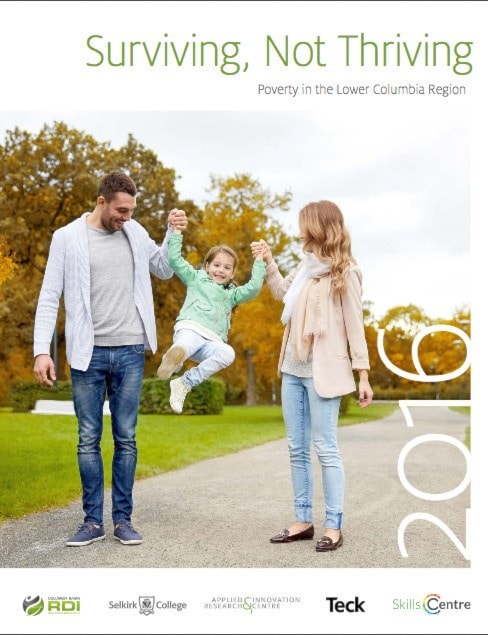Advocates behind a contemporary look at regional poverty are hoping to enlighten communities throughout the Lower Columbia with the facts about economic hardship - only then can the region begin to develop its own poverty reduction strategy.
“We hope people will come to recognize what poverty looks and feels like in our community,” says Jan Morton, executive director of the Skills Centre. “While it includes the homeless person living in back alleys, it may also very well include the family next door who earns less than the living wage and struggles to feel included in the community, and to have a sense of hope about the future.”
In partnership with Selkirk College, the Skills Centre recently released, “Surviving, Not Thriving,” a research report covering topics ranging from income and employment, to food security, housing, early childhood vulnerability, transportation, and recreation.
“The indicators in this report provide insight into poverty in our region,” Morton said. “This information will serve to guide a poverty reduction planning process, which will involve not only people who are living in poverty and agencies delivering services to individuals and families in poverty, but also local government, businesses, and other stakeholders”.

The next step in building a regional strategy involves a summit that will tentatively take place over two days in May.
“The planning process will focus on what we, as a community, can do that increases a sense of inclusion, hope and opportunity amongst individuals and families who live in poverty, ” said Morton, noting Columbia Basin Trust, Teck Metals and Kootenay Savings Credit Union are supporting the event. “The goal is to look for solutions and changes in policy that go beyond short-term charity. Coming out of the summit, we expect we will have identified some specific areas for action on which we can start working as early as next fall.”
One indicator featured in the report is housing affordability, which looks at whether households are spending more than 30 per cent of their income on shelter.
In the Lower Columbia Region – which includes the municipalities of Trail, Rossland, Fruitvale, Montrose, Warfield, and Areas A and B of the Regional District of Kootenay Boundary - more than 20 per cent of all households are in “housing need.” Notably, over half of those households are located in Trail.
Based on available data from 2014, the report notes that most low income individuals or families in the region reside in Trail.
Specifically, Page 12 cites Montrose as having the lowest percentage, or 17.6 per cent of low income families while Trail was the highest at 23.4 per cent. Notably, these statistics are in the category of non-family persons, which is defined as persons living alone and of persons living in a household but who are not part of a couple family or lone-parent family.
For the category of couple families, the lowest percentage of low income was in Fruitvale, at 3 per cent. The highest was in Trail , at almost 4 per cent. For the category of families, the lowest percentage of low income was 8.6 per cent in Montrose while the highest was in Trail at 14.4 per cent. For the category of single-parent families, the lowest percentage was in Rossland (28.5 per cent), while the highest was in Trail and Fruitvale (30.7 per cent). For the category of children in low income families, the lowest percentage was in Fruitvale (12.1 per cent), while the highest was in Trail at almost 15 per cent.

Another insight is the Living Wage calculation, or the hourly wage required to meet the needs of a four-person household, specifically two adults and two children (aged four through seven).
Research shows that a Living Wage for the Lower Columbia is $18.21 per hour – much higher than the minimum wage of $10.85, set by the provincial government.
“A poverty reduction process requires openness, courage, and commitment from many sectors of the community”, added Morton. “We are thankful for the opportunity to receive support to do the research, and now to create an action plan that will look poverty right in the eye.”
The “Surviving, Not Thriving” Poverty in the Lower Columbia Region report is available to the public on the Skills Centre website. Visit communityskillscentre.com and click on “Poverty Reduction” under the “What We Do” tab.
Back
